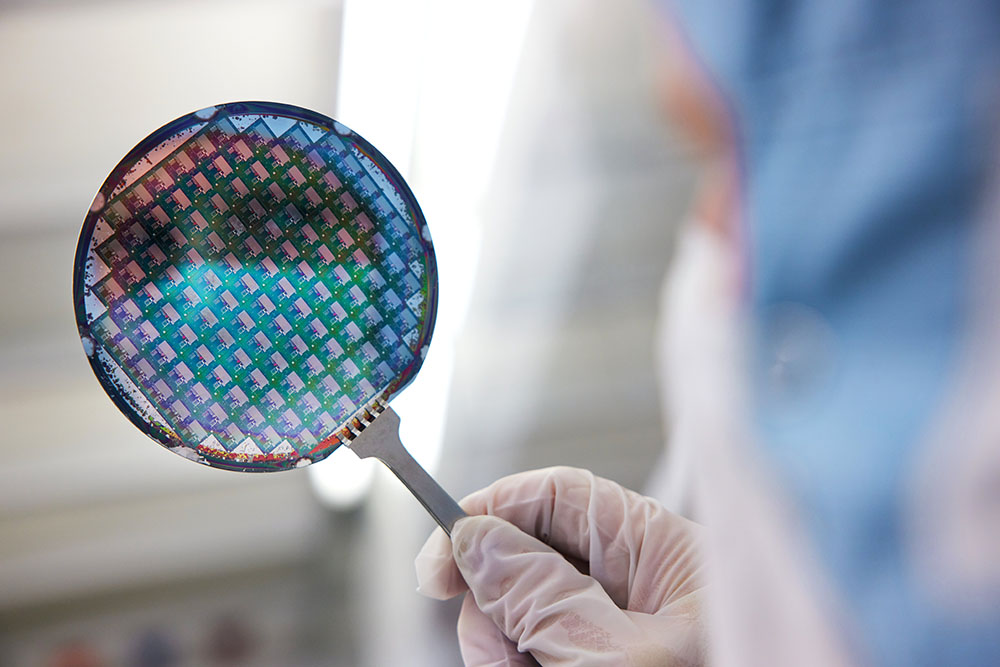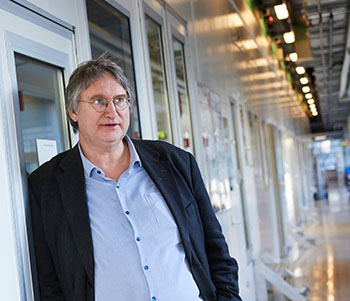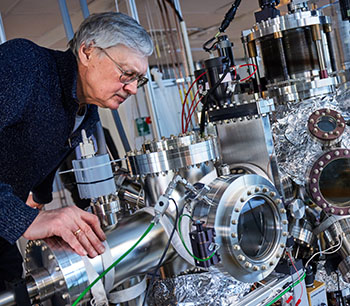"The mix between research and enterprise is unique"

The Electrum Laboratory is on the KTH campus in Kista. It has been serving both higher education and industry with first class knowledge and technology for 35 years. Electrum Lab Director Nils Nordell greets us and explains that these successes are the fruits of the overlap area between researchers and companies.
Electrum Lab is a 1,300 square metres area. Overpressure ensures no dirt can enter. It stands on a vibration free foundation. The Lab has been a fixture here for decades.
As we wander round the large clean room that the Electrum Lab consists of, Nordell talks about the multiyear history of the building. About all the successful companies that have set up camp here, certain of which are still here today. Per-Erik Hellström, Associate Professor at the Division of Electronics and Embedded Systems at KTH is also set to join soon.
“One important cornerstone of the Electrum Lab success stories has been access to production equipment adapted for industry. Of being able to manufacture electronic components down to ten nanometres in size. That each component is exactly the same as its predecessor,” says Hellström.

Both he and Nordell are in agreement that this type of reproducibility is uncommon when it comes to research equipment in similar labs. When you can do this, you can also create extremely advanced components.
Numerous successes
Nordell talks about one such success story that helps explain the way Electrum Lab works. It is a tale of two companies, Radi Medical and Silex. Their journey began in 1994 with a doctoral student project in the Lab where a pressure sensor was used to measure turbulence over aircraft wings. A few years later, the technology was picked up by Radi Medical and used instead as a micromechanical based system to measure coronary artery pressure in the heart and in so doing, diagnose heart function. Swedish company Silex then started manufacturing this technology in Electrum Lab. Eventually demand became so great, that Silex outgrew the Electrum Lab premises and acquired its own production factory.
Both colleagues are in agreement that one of the strengths of Electro Lab is the ability of researchers and companies to find new application areas for existing technology.
“Another success story is KTH Professor Mats Danielsson and his use of Electrum Lab. His company Prismatic, manufactures world-leading X-Ray technology and has now been acquired by GE Healthcare. He was able to manufacture an advanced detector for CT scanners here in the Lab. We provided assistance in freeing up the detectors from silicon wafers,” says Hellström, pointing to the clean room.

Around a score of companies
We walk past the IR Nova part of the Lab, and Hellström says that, on average, one new company moves into the Lab each year. Altogether, over twenty companies have been here over the years. The enterprise is split 50/50 between research and production. This too, is one of the success factors behind the Lab.
“It is a dynamic place, in constant change. The mix between research and enterprise is unique in Europe, maybe even the world. What does this uniqueness offer? For companies, it means the electronics that can be produced here are of higher quality. It also offers the opportunity to test entirely new materials in a simple way. Researchers have the opportunity to produce electronics that require several process steps, in other words, complex technology,” says Hellström.
He personally works with and researches into so-called CMOS - Complementary Metal–Oxide Semiconductors. When it comes to the process, this involves steps that are well into double figures. It is advanced manufacturing, and nothing must go wrong along the way. To assure quality, Electrum Lab is certified to ISO 9001.
All types of work on the scale of Technology Readiness Levels (TRL) are performed in the Lab. From level one that involves very fundamental research where you could be testing a material characteristic, to level nine that is finished products that are sold to customers. According to Nordell, the majority of the work done here falls somewhere between levels three and six.

“One of our strengths is that we are pretty good at communication. We can also help enterprises that are thinking of setting up operations here with everything from licences and permits from public authorities and chemistry, to how the equipment works. And then, we can see a kind of magic emerging inside the Lab when people share the equipment and at the same time talk to each other and exchange knowledge and ideas,” says Hellström.
Silicon that glows
He adds that Electrum Lab is a genuine eco system. It can lead to different effects. Such as a doctoral student who has just defended their thesis, who can then be offered a job with a company that also uses the Lab.
Plus, there is naturally a number of exciting projects that may not necessarily lead anywhere immediately, but can contribute to something positive in the long run. Such as experiments to get silicon to glow. Were you to achieve this, you could produce electronics that require far less energy,” says Hellström. “This is because data could then be moved with the light instead of electricity.”
“There has been a big focus on the shortage of semiconductors in recent years. Electrum Lab may not be able to resolve this problem directly, but it can contribute very much indirectly. This is achieved by educating skilled individuals that in their turn, can help reduce this shortage by building up a semiconductor industry in Europe,” says Nordell.
Change of focus
Electrum Lab has gone through various changes over the years. During its first decade, the focus lay on the telecoms industry, on lasers and transistors. On companies such as Ericsson, the then Televerket and ABB. Then came the millennium shift and the IT crash, and Electrum Lab broadened its activities.
“Many more subject areas were added after that. Such as security, energy, life sciences, and transport,” says Nordell, who points to a spread in an Electrum Lab folder that describes the enterprise today. What has been the biggest event in Electrum Lab’s history? Probably the diversification that happened then, around about the year 2000.”

Nordell also names all the investments in silicon carbide and sensors as part of successes achieved.
“But I am probably most proud of the Lab as a tech incubator that has enabled companies to grow in a systematic and properly thought out way.”
He sees a bright future ahead. Persuading more researchers to join the environment is a priority. Researchers that can develop technology of the future, and create new enterprises with the help of the people and equipment in the Lab.
“And Per-Erik Hellström is now Scientific Director of Electrum Lab. He can not only bring new ideas to the table, but also thoughts on how the infrastructure can be utilised in the best ways, both scientifically and commercially.”

